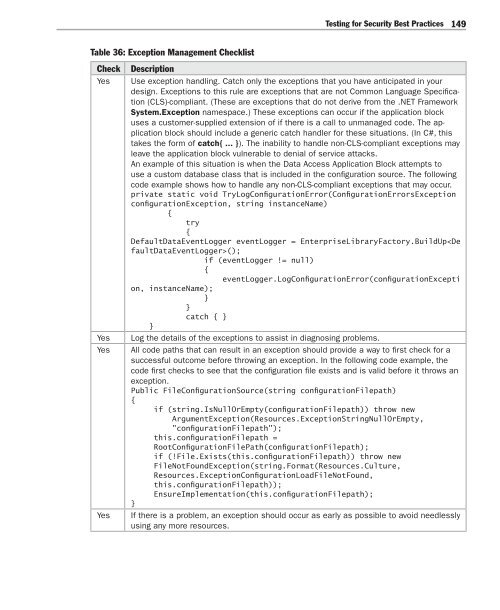Enterprise Library Test Guide - Willy .Net
Enterprise Library Test Guide - Willy .Net
Enterprise Library Test Guide - Willy .Net
Create successful ePaper yourself
Turn your PDF publications into a flip-book with our unique Google optimized e-Paper software.
<strong>Test</strong>ing for Security Best Practices 149<br />
Table 36: Exception Management Checklist<br />
Check<br />
Yes<br />
Yes<br />
Yes<br />
Yes<br />
Description<br />
Use exception handling. Catch only the exceptions that you have anticipated in your<br />
design. Exceptions to this rule are exceptions that are not Common Language Specification<br />
(CLS)-compliant. (These are exceptions that do not derive from the .NET Framework<br />
System.Exception namespace.) These exceptions can occur if the application block<br />
uses a customer-supplied extension of if there is a call to unmanaged code. The application<br />
block should include a generic catch handler for these situations. (In C#, this<br />
takes the form of catch{ ... }). The inability to handle non-CLS-compliant exceptions may<br />
leave the application block vulnerable to denial of service attacks.<br />
An example of this situation is when the Data Access Application Block attempts to<br />
use a custom database class that is included in the configuration source. The following<br />
code example shows how to handle any non-CLS-compliant exceptions that may occur.<br />
private static void TryLogConfigurationError(ConfigurationErrorsException<br />
configurationException, string instanceName)<br />
{<br />
try<br />
{<br />
DefaultDataEventLogger eventLogger = <strong>Enterprise</strong><strong>Library</strong>Factory.BuildUp();<br />
if (eventLogger != null)<br />
{<br />
eventLogger.LogConfigurationError(configurationExcepti<br />
on, instanceName);<br />
}<br />
}<br />
catch { }<br />
}<br />
Log the details of the exceptions to assist in diagnosing problems.<br />
All code paths that can result in an exception should provide a way to first check for a<br />
successful outcome before throwing an exception. In the following code example, the<br />
code first checks to see that the configuration file exists and is valid before it throws an<br />
exception.<br />
Public FileConfigurationSource(string configurationFilepath)<br />
{<br />
if (string.IsNullOrEmpty(configurationFilepath)) throw new<br />
ArgumentException(Resources.ExceptionStringNullOrEmpty,<br />
"configurationFilepath");<br />
this.configurationFilepath =<br />
RootConfigurationFilePath(configurationFilepath);<br />
if (!File.Exists(this.configurationFilepath)) throw new<br />
FileNotFoundException(string.Format(Resources.Culture,<br />
Resources.ExceptionConfigurationLoadFileNotFound,<br />
this.configurationFilepath));<br />
EnsureImplementation(this.configurationFilepath);<br />
}<br />
If there is a problem, an exception should occur as early as possible to avoid needlessly<br />
using any more resources.

















